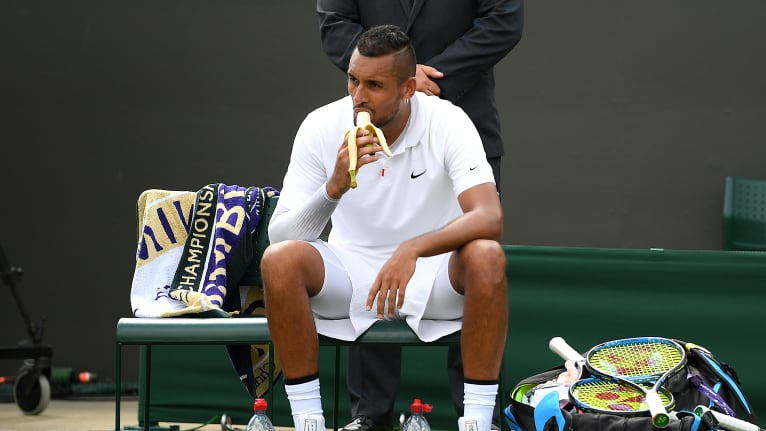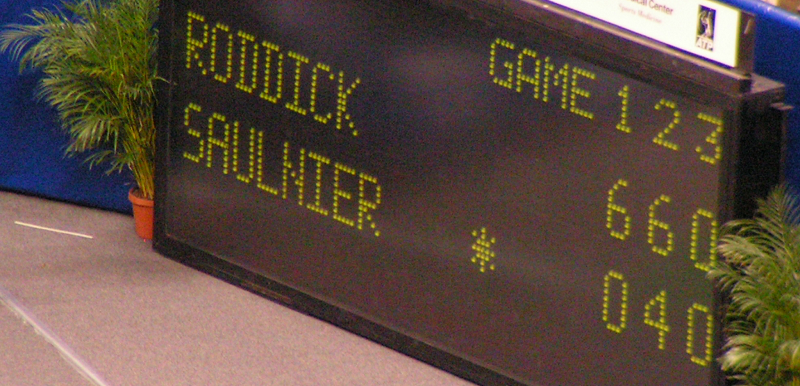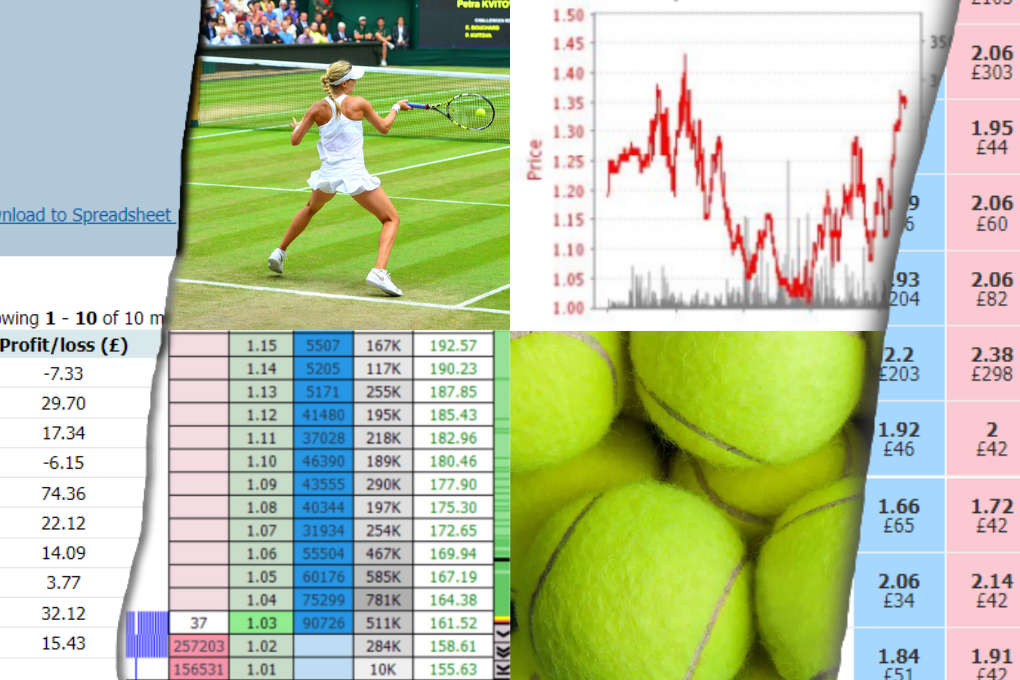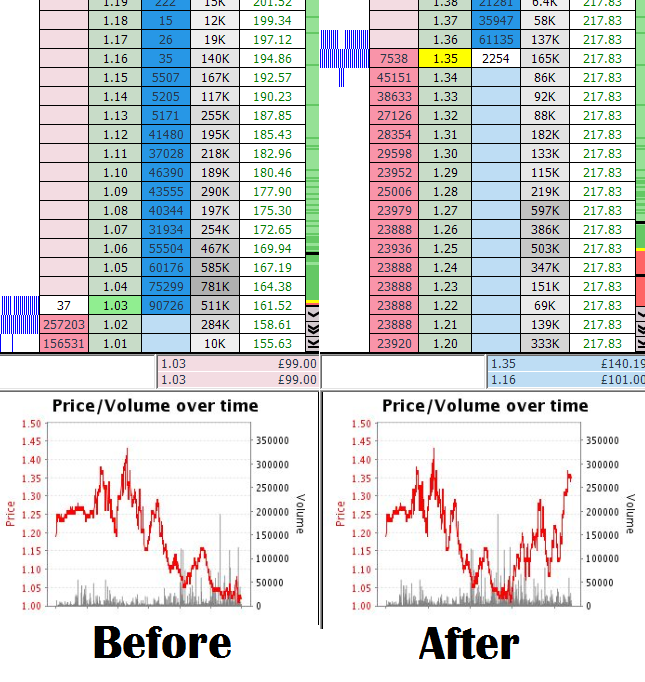Tennis is such an exciting sport to watch, the back-and-forth nature of the game can create great trading opportunities. If you are looking for some simple tennis trading strategies to start profiting from Betfair in 2024, you are in exactly the right place!
In this post, we’re taking a deep dive into five tennis trading strategies, looking at various strategies you can use on the tennis markets. With in-depth analysis and example throughout.
The five key areas we will look at today are:
- 1: Sit-down opportunities.
- 2: Natural compression points.
- 3: Double break profits.
- 4: Playing the serve.
- 5: Points of overreaction.
Tennis Trading Strategies For Betfair
In the distant past, tennis trading strategies have always been a bit feast or famine. The volatile nature of the sports can lead to huge wins but also consistent losses. However, with deeper analysis, I’ve found that doesn’t have to be the case. Tennis trading can bring a reliable income.
Much like horse racing, you’ll need to be aware of how markets behave. Their limitations, such as tennis retirement rules and how certain situations are likely to evolve. And of course; where to place your bets as they happen! (crucial).
The good news is!
Tennis markets often follow suit, forming regular patterns (just like horse racing). After all, any market is just a collection of human behaviour, which makes things predictable.
Whilst it’s helpful to know a fair amount about the specific players, in my opinion, it is not vital.
Either way, there’s the opportunity to make a few quid. The simplest tennis trading strategies are built more around the market, numbers, and compression points in particular. Supposed to be player-based knowledge. Putting the two together though is much like trading gunpowder!
As mentioned in the tennis trading pdf (mentioned above) there is one particular strategy that’s easily used to exploit the market.
All good trading strategies centre around one key thing; a solid plan.
Having a plan and sticking to it removes the margin for error, managing risk and maxing out your upside. Better still, it allows you to see when you made an impulsive mistake. Meaning you don’t question your overall tennis trading strategies every time you use them.
#1 Sit Down For Easy Profits: Betfair Trading Strategies
When it comes to profitable tennis trading, one of the simplest strategies is to focus on the breaks in play. Yes, you heard that right.
People often think of huge in-play swings but one of the lowest risk times to trade on tennis is whilst tennis players are taking a water break and sitting down. By trading the market momentum and price activity while they do this we are afforded a solid trading opportunity, especially if the favourite’s serve has been broken.

Biases exist everywhere, but tennis trading is extremely low-risk when approaching it this way. Simply put, there isn’t going to be a 20-tick swing in prices within seconds.
That old adage of ‘manage the downside and the upside will come’ springs to mind. With key tennis tournaments like Wimbledon, this is great on very high stakes too.
There’s a detailed section and video specifically about this strategy in the tennis trading guide.
#2 Compression Points: Betfair Tennis Trading Strategies
 In tennis, there is often a situation where the market will move more in one direction than the other. But be aware: as the game goes on, things can get more and more erratic. Be very careful if you’re still contemplating betting in the final set (if you’re taking a position as to how the game will end, it’s best to be done with previous profits).
In tennis, there is often a situation where the market will move more in one direction than the other. But be aware: as the game goes on, things can get more and more erratic. Be very careful if you’re still contemplating betting in the final set (if you’re taking a position as to how the game will end, it’s best to be done with previous profits).
Late in a match, the markets can turn into a real roller-coaster, which of course brings its own value too! I won’t mention any here, although there are some killer tennis trading strategies to be used at the end of a match. Just think about it – overreactions often produce valuable trading opportunities.
Historically, people make money fast when others panic.
Before employing this strategy it’s best to do some homework. The more you know about the individual player, the better. Some struggle more under pressure than others…
The biggest downfall in tennis trading, much like racing trading seems to be a lack of discipline. Tennis trading strategies are often a lot more mechanical. With there being only two players it’s always going to be that way.
So what’s a ‘compression point’?
During a tennis match, there are often several points of ‘compression’ within the market. These points often arise at crucial points of the game, which is a double bonus. When opening a trade at a point of compression the market is offering more reward in one direction than the other. We don’t win every time, but the payoff exceeds the risk of playing.
Look at this graph as an example, taken from a previous blog post:
If you look at the profit and loss column above, you’ll see the potential loss is £6. To make the same amount of profit the price would only need to hit 1.05. However the upside on this trade is massive!
Look at where the area the red line becomes more solid. Tennis trading strategies thrive on these points within a game. Everyone wants to place a bet where the payout is more than the loss, right?
So if the market is ‘compressed’ at this point, there is a potential opportunity already. But let’s not be too hasty. To get that profitable gunpowder-like effect, we need to have a reason to open the trade.
Fortunately, in tennis, there’s always more than one set to be played in any one match. This is often the easiest place to spot one of these opportunities. At the end of a set, the price will have reached compression in one direction or another. On top of that, it can prove a rather high-pressure situation for the players. Especially if the underdog has to serve to win the set. More on the serve in a moment.
So just to make it crystal clear:
When the market reaches a point of compression (lower the price the better). And you have a good reason to bet, such as increased mental pressure on the players. It makes for a good opening trade. In the past, this has produced some hefty wins on the tennis. One of the most reliable tennis trading strategies I know of, particularly if you do your homework first.
Can you think of a time when the price might be compressed, with additional mental pressure bearing down on the players? end of the first set maybe?
Betfair Tennis Tips:
Gaining an insight and understanding player characteristics/traits can help develop an edge in the markets. Players react differently depending on a number of metrics such as surface conditions, time between last games etc. Below we have listed some of the best tennis statistics sites to help you build you out.
Here’s a YouTube video I made some time ago. It briefly outlines the first of the tennis trading strategies mentioned:
There are other compression points within a match if you look hard enough. I won’t share them all as they’re included in our courses but there are plenty.
In my experience, the best tennis trading strategies are built around compression points. Make sure you’re careful if playing at a volatile point within a match though, poor discipline will find you out every time!
This leads me to the next point of interest…
#3 – Double Breaks in Tennis Trading
A double break in a service can offer great opportunity to profit when it comes to tennis trading. Particularly in women’s tennis…
Breaks in service back and forth many times throughout a match offer a unique opportunity. You see, when there’s been a double break the betting exchange markets are literally as far as they can go at that point in time. It offers a great risk versus reward ratio.

The earlier in a set, the better. After all, there’s more time for the breaks in service to be recovered. There have been many occasions in the past where a tennis player is trading at 1.04 with a double break in their favour, only for the entire match sentiment to reverse 20 minutes later (priced above 2.0).
Here, at these points of a double break, tennis trading strategies are afforded minimal risk and downside with huge upside potential. Be patient, wait for these opportunities and then hit them hard for your own benefit!
#4 Playing the Serve – Betfair Tennis Trading Strategies
Serving within tennis is a very big deal. Anyone that has played tennis will know this.. This is because a server often has an advantage over its opponent. In terms of building profitable tennis trading strategies, this is of great use. If you know when a player is under pressure, you can trade accordingly. Adversely it could help you in making a decision to exit a trade.
Each time a player’s serve is broken the market will react more than if would have if it was held. The only problem is, players often hold their serve, more so in ATP matches. Court surfaces can have a substantial effect on the reliability of a player’s serve as well. If you look hard enough you’ll start to see patterns where service games are broken.
So how do you make the most of this?
Tennis trading strategies like this rely heavily on the players in question. It’s always advisable to go against the serve, as the market reacts more (creating a bigger profit). Going with the service is possible, although only in specific situations.
For example; If John Isner were playing a relatively low-key match, on a hard court surface it’s unlikely there would be many breaks in serve. John Isner has one of the highest statistics for winning his first serve.
If you bear in mind the point of play also, say the second or third match of the first set, mental pressure will be very low. In this instance, it may be a good idea to go with the serve for a game. Although I should warn you to be select! If service is broken the market will move more in the opposing direction.
It’s also possible to work this method in the alternate direction. If a player is particularly poor under pressure, playing on a slow surface like clay then it may be beneficial to lay them. This is where knowing your tennis can really help.
Knowing a tennis players characteristics/mental state when serving can you give you an edge!
Playing the serve has far more opportunity to us within a match, although it isn’t the most reliable of tennis trading strategies. But keeping its use to specific situations, combined with player knowledge can make it a useful tool.
To recap:
- Markets react more to breaks in serve
- Your approach needs to be specific to the situation
- Court surfaces will change the dynamic
There’s a hefty clue in the next section, so make sure don’t miss a thing…
#5 Market Over-reactions – Betfair Tennis Trading Strategies
In every type of market on Betfair, there are over-reactions. People make mistakes! we’re only human at the end of the day.
For the patient trader, it can be really quite profitable, whatever your sport is. The main difference between trading tennis and racing is the regularity of opportunities. In tennis you may have to sit and wait for several games watching before making a move. However, you might get a bigger profit for that one move.
Offering a price always carries value. The more consistently you pick up value, the quicker the balance will grow. All tennis trading strategies rely on value in one form or another, this is one of the best as you don’t actually have to know anything about tennis.
The video below was created for another blog post as it applies to so many different markets. I’ll explain the exact idea behind what I’m doing after the clip…
Video Pointers
You can see at 3.40 in the video I place a lay at 1.14 and 1.15. This is because I want to offer a bet in the market at a point where I may be matched by someone else, giving away value. If it doesn’t get matched I don’t lose. If the point is won and moves to my position I can either get out for no loss or at the very worse case lose 1 tick.
Making it an ideal low risk, high reward trade.
Fortunately, it got matched, leaving a big enough gap in the market to provide me the opportunity to exit for a profit. For a worst-case loss of 1 tick, I managed to gain 3.5 ticks, I’m sure the shrewd amongst you won’t take long to realise there are other tennis trading strategies directly related to this.
If only all tennis trading strategies were risk-free! This one really is. The problem comes when you wish to increase stakes on a large scale, which is why I don’t mind sharing it publicly! Give it a go!
Hopefully, this insight will have given you a first starting point to build up a list of tennis trading strategies.
To recap:
- Anticipation is an advantage
- Understanding the situation reduces stressful execution
- Only play when you have an unfair advantage
- Being patient costs you nothing
As with all trading on Betfair, knowledge is key. Putting one or two reasons for a trade together often make for the most positive results. Ensuring you test each strategy over a large enough sample, and keeping to the plan is important. The more information on offer, the easier things become!
What not to do…
It’s quite normal to get over-excited and start betting heavily once you find some useful tennis trading strategies. But be aware; each situation and tournament is different.
Different surfaces, players, locations and even crowds can make a difference to a match. Especially if it’s a final where a lot is at stake. Stick to a regular staking plan to avoid unnecessary highs and lows!
Overall we have covered 5 really solid Betfair tennis trading strategies. That you can look at using as you tackle the tennis trading markets.
If you want to really develop your tennis trading skills further and learn how to effectively trade the tennis market on Betfair it’s worth considering our Tennis Trading Guide. Which covers how to make a long term profit from the tennis markets, highlighting the best situations to use all the strategies we have gone over in this article.
Similar Article: Horse Racing Trading Strategies to Help YOU Win More…



30 thoughts on “5 Simple Tennis Trading Strategies for Betfair: Low-Risk, High Profit…”
Hi Caan,
Thanks for the video re the tennis trading. Couple of questions please, if I may:
Does this work for both WTA and ATP games, or is it best for the women’s game due to the number of breaks of serve?
Also, do we look for matches where they are fairly equally matched at the start, indicated by the close odds pre-game? Does this not work as well where there is a heavy favourite pre-game?
Thanks again
Simon
Hi Simon, WTA is preferable.
As you suggest, it’s better tennis trading strategy when there is equal game going on… sometimes the odds dont reflect it mind.
Do you find tennis trading more stressful than pre-race horse trading?
I think its more like I find it less interesting…. obviously the WTA is rather watchable. But horse racing markets are more frantic and exciting.
1.23 was a good price to lay especially when you look at bet365 offering 1.22 at the same time. Out of interest, what price did you think Back should be at that point? Is that a factor in your decision making?
Thanks
Chris
Not really no, Chris.
Hi do you have any good tennis trading guides or books such as you pre race trading guide?
I am new to tennis trading would like to get to speed with it .
HI Haran, not at the moment! Couple of good people on twitter though as i believe…
Not currently 🙂 Sorry.
Hi Caan,
i’m going to buy your training guide, just have to wait for pay day. one thing that concerns me all the time is betfair crashing. it happened to me again last week and it wiped out my 200 quid bank. how do you cope when it crashes and you have a large matched trade in the market?
cheers, clive
How did you lose the £200? I was playing around with £200 stakes on practice mode trading pre-race when it crashed and I was on an open lay trade on odds of 7/8 ! If that horse had won ( I didn’t even want to look ) I would of lost a lot !!.
Since that moment I have pretty much given up on the idea even though I was making progress I now don’t see the point if one day Betfair crashes and wipes me out !
The only advice I can give is make sure you are using another exchange with enough money to lay of your bet and try to stick to backing not laying.
I think I will always have a play around with the horses but only with £20-£50 stakes depending on the odds.
Also made me think how much money people lost and who ended up with it all ??
Nice way for them to boost the bank and nothing anyone can do…..
It very rarely happens where I have been caught but usually its straight on the phone and if not to hedge on betdaq
Why no post ?
You’ve lost me ?
Knowledge > Lamborghini. =D
Tried this out a few times today, it’s a nice strategy.
I’m laying the 1st set winner right after she wins the set, when the price appears to have bottomed out. Obviously you can never 100% know when the price has truly bottomed out, but you just get a good sense I suppose.
It’s worked on two matches but I’m on one match (Reix vs S Sanders) where it’s currently looking like it may not work. Problem with this match is that S Sanders completely blitzed Reix right out of the 2nd set after winning the first set 6-1, so the price dipped even further.
So I think I’m going to stay away from matches where one player completely dominates another in the first set. However it seemed to work nicely in those two matches where the 1st set winner won 7-6 (ideal because the match is mixed and up for grabs) and 6-2. What do you think?
It’s all learning! 🙂
after years of losing on tennis, I am finally realising, that the points you make about getting value on tennis trades, is where I have been getting it totally wrong, thanks for posting these blogs, its really opened my eyes. ( I see Sharapova is giving a couple of tips out also, in the top photo 😉
No problems PJ.
Hey Caan,
Thanks for this post it is extremely informative. I like the points made at #2 as it confirmed my thinking about the various tennis trading strategies on Betfair. I’ve read many articles about this kind of thing across the internet and none go in the kind of depth you have here! Thanks ever so much. Your free content is brilliant keep up the good work!
JJ
No problem. Glad it helped 🙂 tennis is a bit of a different beast to trade when compared to the likes of other sports. Cheers
No problem, glad it was useful to you!
Hi Caan,
Just stumbled upon the concept of Sports Trading and came across your YT and this site. Absolutely phenomenal stuff. Trying to follow your videos and that as well as the Geek Toys Software you use.
Above under #1 strategy ‘Compression Points’ you say:
“If you look at the profit and loss column above, you’ll see the potential loss is £6. To make the same amount of profit the price would only need to hit 1.05”
Pardon me for being dumb, but I can’t see to see where this is?! Would love if you or someone else could help me out reading the numbers to see where this comes from?
Thanks mate.
Hi Alan,
No problem. If you take a look at the profit and loss column. You can see the diference in values in line with the potential prices. Where the two betting columns butt up against each-other is the current trading price.
Caan
Thanks for the response Caan. Ah yes I see it now 155167! I was focusing on seeing a red minus 6 not realising that losing existing profit on the trade is still a loss 🙂
Thanks mate,
Alan.
Hi Cain,
Why do you imply that betting with serve is not a good thing. I’m no expert and I’m dabbling as a challenge, trying to view cash as numbers to take out the emotion. I tend to win on betting with serve , so long as I don’t chase losses. However, I do switch about a bit and avoid betting when it’s obvious a players serve is under pressure. I try to get in when the value is there before the game starts a cash-in at the end of the game unless I have formed a view that there’s a good chance of breaking serve next game; in this case if things go awry, nothing lost. It seems to work. I am not betting big sums though, maximum £20 at the moment. If I keep calm, I should build up the pot and will increase the numbers involved. Your betting against serve strategy feels like all or nothing?
Why? Because in almost every case – it’s not. There are some extreme situations, but i woudlnt want to mislead anyone that’s learning to trade tennis. The market is against the serve in numerical values, excluding situations where there may be a very heavy bias in momentum.
Caan,
Thanks , think I’ll take a step back and observe, I “think” I get you. When I go with serve there’s generally “seat of ones pants” moments during the course of the game unless it’s a love game. I presume that any of these moments if going against serve is an immediate opportunity. The jump in the odds is more significant.
I’m wary at the moment because I took a hit after I posted on here last night and therefore can see the error in my ways as of now.
Hi Caan,
I have mainly left tennis alone and am more cautious than I was. I’d be interested in your view on something entirely different (not tennis but like tennis a two-horse race) as I’m really puzzled.
I have money on a yes/no UK politics outcome by the end of the calendar year (the market closes when either the event happens of the year ends without it happening). In this case I knew my stuff on the subject and at the point when the outcome was a certainty I had £425 clear guaranteed (i.e. green screen) on Betfair. I thought that was that “no” was the certain winner as the UK parliament went into recess until 8 January making “yes” a literal impossibility, however…
…I kept an eye on the market, to my surprise following movement in the market (a raft of bet money disappeared) I got a £60 bet accepted at 1.24 (4-1 on). This produced a guaranteed increased win of £15 which I left running. The same thing happened the next day (early hours of the morning), this time I got my entire remaining money on at 1.16 increasing the win to a guaranteed £487. On this occasion though I laid the whole lot off at 1.01, giving away £4.82 to green screen at circa £480. Lightening has not yet struck 3 times and the market is now likely to be dormant save for potential position closing until 00:01 on 1 January 2020
I’m obviously not complaining but am puzzled because we are talking about a true dead cert here. There seem to be two possibilities (1) bots or auto-systems are running which do not recognise that the outcome is certain (2) there are real people betting who mis-misguidedly consider “yes” to be a possibility. Have you seen this yourself, could both or either of my theories be reality (I have my doubts about the latter possibility)? The scenario would be the same as say a tennis market based on a player winning a defined number of tournaments by a defined date and there being no tournaments happening.
Hi Caan,
thanks for the info in this article, have a few questions. if I’m typically looking for a break of serve and getting in at the right price .how often can you do this or does it come along in a tennis match?, usually is it just done once in a game (WTA 3 SET MATCH ) also if I try it and it doesn’t work do I take the small loss and get out? also, do I set my exit point once I have entered the trade.
Great post! I’ve been implementing some of these strategies and have seen a significant increase in my trading profits. The parts about hedging and scaling out made the most sense to me and I’ve noticed a substantial reduction in my losing streaks. Keep up the good work!